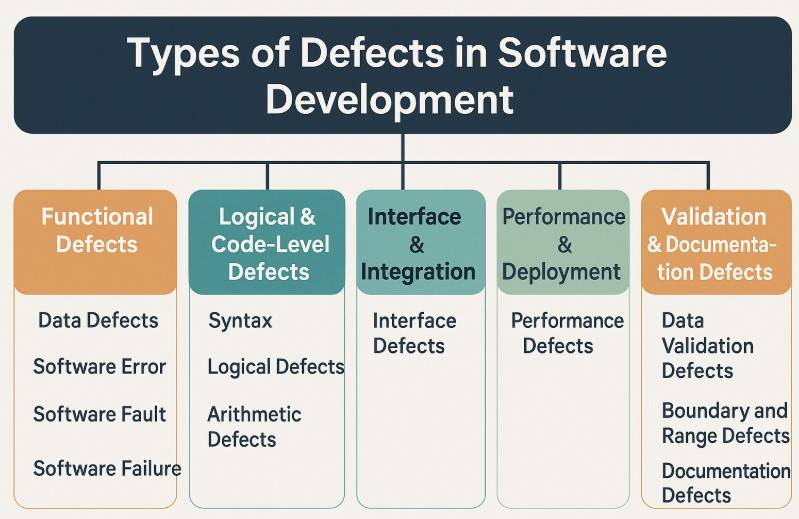Types of Defects in Software Development
A defect in software development is any flaw that causes unexpected behaviour, often impacting performance, accuracy, or usability. Understanding the types of defects is essential because each type highlights a specific problem area, whether in - code, logic, interface, or system design. By accurately classifying defects, teams can resolve them more quickly, ultimately improving the software's overall quality.
In this article, we will explore common defect types, such as syntax errors, logical flaws, and integration failures. To better understand them, we have grouped similar defects together, given real-world examples, and shared effective strategies for preventing them.
Interested in making a career in software engineering? If so, pursue software engineering courses and certifications online. And in case you are not sure whether the field is for you or are short on funds, opting for free software engineer courses and certifications online will be a perfect choice!
Table of Content (TOC)
- What is a Defect?
- Types of Defects in Software Development
- Functional Defects
- Data Defects
- Software Error
- Software Fault
- Software Failure
- Logical & Code-Level Defects
- Syntax Defects
- Logical Defects
- Arithmetic Defects
- Multithreading Defects
- Interface & Integration Defects
- Interface Defects
- Integration Defects
- Performance & Deployment Defects
- Performance Defects
- Deployment Defects
- Validation & Documentation Defects
- Data Validation Defects
- Boundary and Range Defects
- Documentation Defects
- Functional Defects
- Best Practices to Follow While Designing Software
What is a Defect?
A defect in software development is any flaw or issue that causes a program to behave unexpectedly. It may result from errors in code, logic, or system design. A defect can impact the software's functionality, performance, or usability, causing it to behave in ways that were not intended.
Defects can occur at any software development life cycle stage, from planning and design to coding and deployment. They may be simple issues, like a typo, or more complex problems that affect the entire system. Identifying and fixing defects quickly is paramount to ensure software works as expected and meets user requirements.
Best-suited Quality Assurance & Testing courses for you
Learn Quality Assurance & Testing with these high-rated online courses
Types of Defects in Software Development
Software defects vary depending on how, where, and when they occur. Grouping similar defects makes it easier to identify, fix, and prevent them. Below are common types of defects classified into key categories.
Functional Defects
These defects prevent the software from doing what it's supposed to do. They occur when a feature is broken or missing.
- For example: A user clicks "Apply Coupon" during checkout, but nothing happens.
- Prevention Tip: Match each feature with its requirements and test all user actions.
Here are some of the common types of functional defects:
Data Defects
These defects relate to how data is stored, displayed, or processed. They lead to data mismatch or loss.
- For example: A student's date of birth shows as "04/31/2025" after form submission.
- Prevention Tip: Set strict input, storage, and output data rules.
Software Error
Software fault is an undetected error made during development. It can be a mistake in logic, a typo, or a wrong function call.
- For example: A billing system charges INR 0 because the developer forgot to multiply quantity and price.
- Prevention Tip: Review code regularly and use automated tools to catch basic errors.
Software Fault
A software fault is an undetected error in the system. It may not cause problems right away but can break later.
- For example: An app crashes only when a user uploads a file larger than 2GB.
- Prevention Tip: Test with rare and extreme inputs to find hidden issues.
Software Failure
A software failure happens when a fault causes the system to behave wrongly in real use.
- For example: A food delivery app accepts an order but doesn't send it to the restaurant.
- Prevention Tip: Run end-to-end tests that mirror real user journeys.
Logical & Code-Level Defects
These defects occur inside the code. They happen due to bad logic, syntax errors, or wrong calculations. They don't always stop the program, but they lead to wrong results or unexpected behavior.
- For example: A tax calculator applies 10% instead of 18% due to a logic error.
- Prevention Tip: Use unit tests and code reviews to catch logic issues early.
Here are some of the common types of logical and code-level defects:
Syntax Defects
These are mistakes in how code is written. They stop the code from compiling or running.
- For example: Missing a closing bracket in a JavaScript function causes a page error.
- Prevention Tip: Use IDEs or code editors with syntax highlighting and error checks.
Logical Defects
These arise when the code runs but gives the wrong result due to flawed logic.
- For example: A school app marks absent students as "Present" because the logic checks "if status = Present" instead of "==".
- Prevention Tip: Write unit tests to check expected outputs for all logic paths.
Arithmetic Defects
This type of defect happens due to incorrect calculations or incorrect formula operators.
- For example: An EMI calculator returns INR 9,000 instead of INR 900 because of a misplaced decimal.
- Prevention Tip: Use test data with known outputs to confirm correct results.
Multithreading Defects
These defects occur in apps that perform many tasks at once. Threads may clash, causing delays or wrong results.
- For example: Two users update the same record at the same time, and one change gets lost.
- Prevention Tip: Use thread-safe operations and test concurrent activities.
Interface & Integration Defects
These defects relate to how the system looks and connects. Interface issues confuse users. Integration bugs break how different systems work together.
- For example: A form loads, but the labels are cut off, or a payment gateway link fails.
- Prevention Tip: Test both user experience and system-to-system connections carefully.
Let's explore each of these different types of defects:
Interface Defects
These relate to how users interact with the app. Poor or missing elements can confuse users.
- For example: A red error message disappears too quickly for the user to read.
- Prevention Tip: Test the interface for clarity, colour contrast, and helpful messaging.
Integration Defects
These occur when systems or modules fail to work together. Data may not sync, or actions may fail.
- For example: A learning app fails to load student records from the database due to a mismatch in field names.
- Prevention Tip: Test all module connections with real-time data and edge cases.
Performance & Deployment Defects
These defects appear after the system is launched or when it faces load. They slow down the app or break it on production.
- For example: The site becomes unresponsive during an online admission rush.
- Prevention Tip: Run load tests and prepare deployment checklists.
Let's explore each of these different types of defects:
Performance Defects
Performance defects make the software slow or unresponsive. They usually appear when many users access it at once.
- For example: An exam portal takes 30 seconds to load each question during peak hours.
- Prevention Tip: Run load tests to measure speed and fix slow code.
Deployment Defects
These types of defects show up when moving the app/software to live servers. They break functionality or block access.
- For example: The live app doesn't open because the server lacks a key configuration file.
- Prevention Tip: Automate deployment and test it in a production-like setup.
Validation & Documentation Defects
These types of defects affect how users give input and understand the system. Invalid inputs or wrong documents lead to confusion and errors.
- For example: A form accepts letters in a phone number field. Or the help guide is outdated.
- Prevention Tip: Validate inputs and keep user documentation updated.
Here are some of the common types of validation and documentation defects:
Data Validation Defects
These occur when input isn't checked properly, leading to invalid or risky data.
- For example: A user registers with "abc" as their mobile number, and the app accepts it.
- Prevention Tip: Add strict input checks on both the frontend and backend.
Boundary and Range Defects
These arise when values go outside expected limits. The software fails to handle such extremes.
- For example: A fee calculator fails when a student enters 100 courses instead of the limit of 10.
- Prevention Tip: Define and test minimum, maximum, and edge values for all inputs.
Documentation Defects
These defects relate to incorrect or outdated guides, help content or instructions. They confuse users or developers.
- For example: A manual says "Click 'Export to PDF'" but the button is labeled "Download Report".
- Prevention Tip: Review and update documentation every time a feature changes
Best Practices to Follow While Designing Software
Here are some of the best practices that should be followed:
- Start with precise software requirements before creating any design components. Doing so will ensure that the final product meets user needs and business goals without rework.
- From the beginning, break the system into smaller, manageable modules. This modular design helps with testing, debugging, and scaling the software efficiently.
- Use design patterns to solve recurring problems in a proven, maintainable way. Apply patterns like MVC or Singleton when appropriate to improve structure and reusability.
- Create wireframes or mockups before writing the actual code. Visualising the UI and workflows will help you catch design flaws early and align stakeholders.
- Define clear data flow and control flow in all modules. This avoids confusion during implementation and reduces the chances of logical errors.
- Based on the project size and scope, choose the right architecture for the application. Based on performance and integration needs, you can use layered, microservices, or event-driven architecture.
- Always design APIs with versioning, authentication, and input validation in place. This makes your APIs secure, backwards-compatible, and reliable across updates.
- Make sure the software design supports scalability and performance under load. To handle high traffic, you can use caching, asynchronous calls, and efficient algorithms.
- Follow naming conventions and consistent coding standards from the start.
- Document design decisions, architecture diagrams, and workflows clearly, as this will help new team members understand the system and reduce dependency on individuals.
- Include exception handling and fallback mechanisms in all critical flows. Doing so will prevent software crashes and ensure the system recovers gracefully from errors.
- From day one, design the system with security in mind. Encryption, role-based access, and input sanitization can be used to protect against threats.
- Test the design using prototypes or proof-of-concept models before full development. Doing so validates assumptions and avoids investing in flawed design approaches.
- Ensure the design supports CI/CD and automated testing workflows to improve release speed and make the product more reliable in the long run.
Conclusion
Software defects can appear at any stage of development. Each defect affects performance, reliability, or user experience. By understanding the different types, teams can detect issues faster and fix them early.
Using proven design practices helps reduce the chances of defects. It also ensures the software meets user needs and works well under real-world conditions.
Every development team should aim for clean design, strong validation, and thorough testing. These steps lower risks and improve product quality. And the bottom line - Preventing defects is always better than fixing them later!










